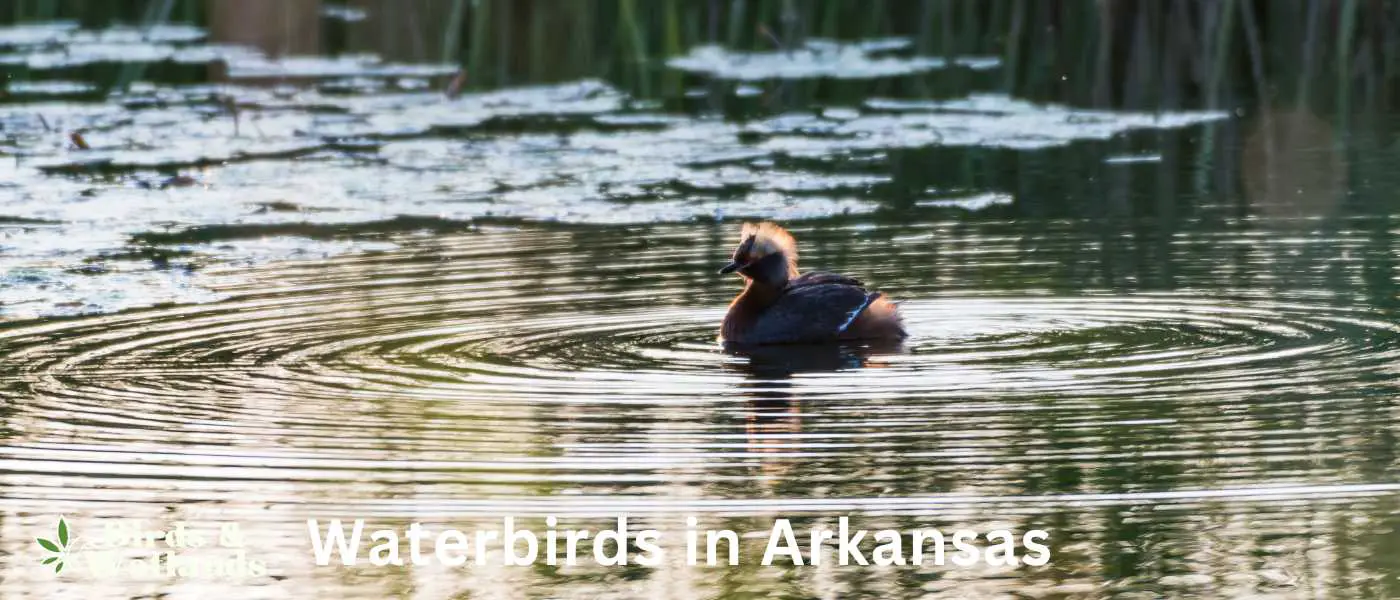There’s something remarkably serene about observing water birds in Arkansas. Nestled within the heartland of America, the natural beauty of this state offers an ideal habitat for an array of avian species, particularly those who thrive near water bodies.
The state of Arkansas is a bird-watcher’s paradise, boasting a vibrant ecosystem teeming with varied water bird species. Whether its wading birds or diving ducks, Arkansas birds have something for everyone.
Arkansas Water Birds
| Water Bird Species | Frequency in Arkansas | Specific Locations in Arkansas |
|---|---|---|
| Mallard | Common | Big Lake National Wildlife Refuge |
| American Wigeon | Common | Bell Slough Wildlife Management Area |
| Northern Pintail | Common | Bald Knob National Wildlife Refuge |
| Northern Shoveler | Common | Harris Brake Lake Wildlife Management Area |
| Blue-winged Teal | Common | Bayou Meto Wildlife Management Area |
| Wood Duck | Common | St. Francis Sunken Lands Wildlife Management Area |
| Bufflehead | Uncommon | Lake Dardanelle State Park |
| Hooded Merganser | Common | Cache River National Wildlife Refuge |
| Black-bellied Whistling-Duck | Rare | Mack’s Prairie Wings, Stuttgart |
| Ross’s Goose | Uncommon | Overflow National Wildlife Refuge |
| Greater White-fronted Goose | Uncommon | Wapanocca National Wildlife Refuge |
| Snow Goose | Common | Augusta City Park, Woodruff County |
| Trumpeter Swan | Rare | Magness Lake, Heber Springs |
| Green Heron | Common | Fourche Creek, Little Rock |
| Great Blue Heron | Common | Lake Conway, Faulkner County |
| Spotted Sandpiper | Common | Arkansas River Trail, Little Rock |
| Great Egret | Common | Millwood State Park, Little River County |
| Cattle Egret | Common | Fayetteville, Farmington Bay |
| White-faced Ibis | Uncommon | Black Swamp, Randolph County |
| Common Loon | Rare | Beaver Lake, Rogers |
| American Coot | Common | Craighead Forest Park, Jonesboro |
| Double-crested Cormorant | Common | Lake Chicot State Park |
| Pied-billed Grebe | Common | Arkansas Post National Memorial, Gillett |
| Eared Grebe | Rare | Lake Fayetteville, Fayetteville |
| American White Pelican | Common | Lake Hamilton, Hot Springs |
Water Bird Species Found in Arkansas
Mallard

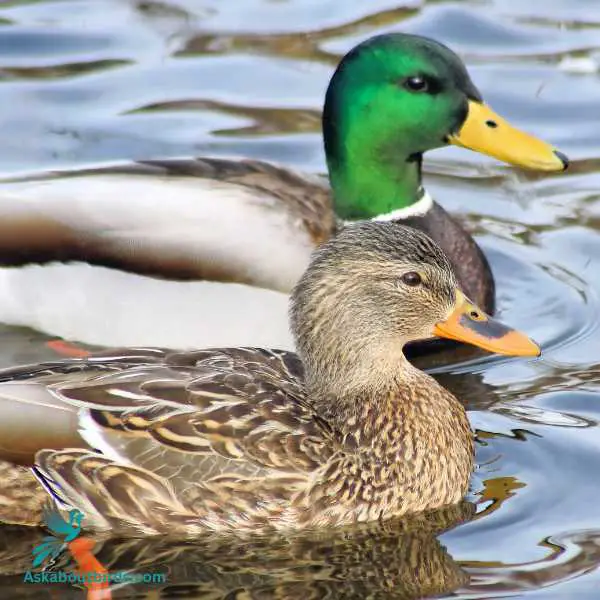
| Feature | Measurement |
|---|---|
| Scientific Name | Anas platyrhynchos |
| Length | 20-26 inches |
| Wingspan | 32-39 inches |
| Weight | 1.6-3.5 pounds |
The Mallard, one of the most recognizable of all ducks, is distinguished by its classic “quack” and its common presence in city parks and wild wetlands.
Appearance: Mallards are large ducks with a hefty body and rounded head. The male is notable for its glossy green head, gray body, and black tail-curl, while the female is mottled brown with an orange-brown bill. Both sexes have a white-bordered, blue “speculum” patch in the wing.
Diet: Mallards are omnivorous, dabbling ducks that eat a wide variety of foods. They are known to feed on aquatic vegetation, insects, worms, and grains. In city parks, they are often seen eating bread, popcorn, and other food provided by humans, although such items are not part of their natural diet.
Reproduction: Mallards nest on the ground on dry land that is close to water, under cover of tall grass or other vegetation. The female typically lays around 8 to 13 eggs and incubates them herself.
American Wigeon
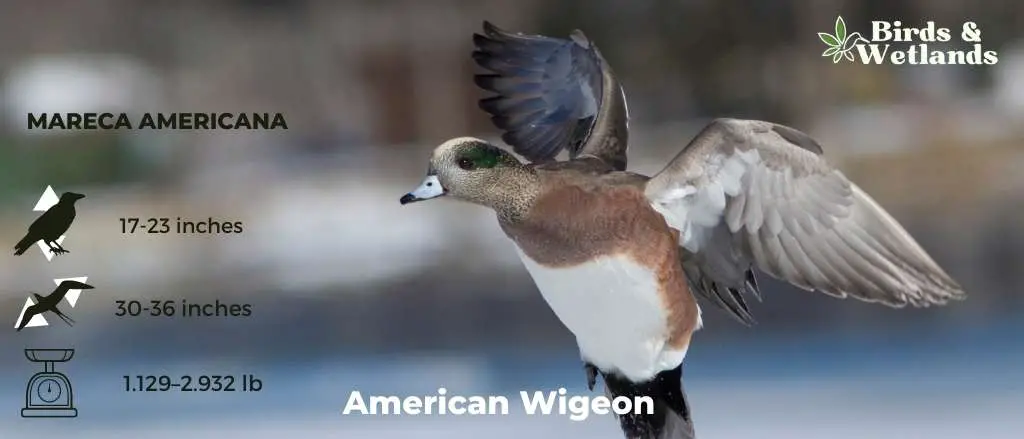
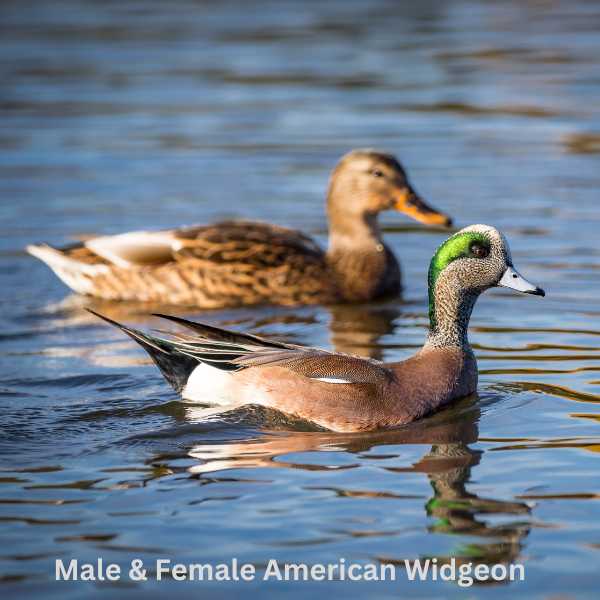
Listen to American Wigeon
Scientific Name: Mareca americana
Length: 17–23 in
Wingspan: 30–36 in
Weight: 1 –3 lb
The American Wigeon is a medium-sized duck species that is a popular sight in wetlands, ponds, and lakes and is often seen in mixed flocks with other ducks.
Males of the species are recognized by their distinctive appearance. They sport a unique white forehead and crown, coupled with a green band stretching from the eye to the back of the head. The body is mainly gray with a pinkish hue on the chest. Females are more subdued in color, with primarily gray and brown tones.
Diet: comprising mainly plant material like aquatic vegetation and grasses, but it also includes insects and other small invertebrates. They are known for a feeding behavior called “kleptoparasitism,” where they often snatch food from other ducks.
American Wigeons usually breed in the northernmost parts of North America. The females create their nests on the ground, often hidden in tall grass near water bodies. They lay a clutch of 6 to 11 eggs which they incubate for about three to four weeks and the ducklings feed on small aquatic invertebrates and aquatic insects.
Northern Pintail
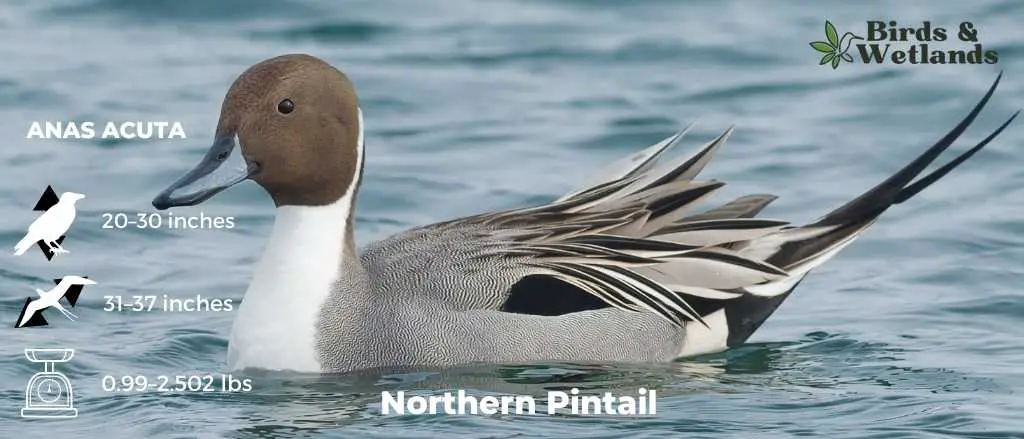
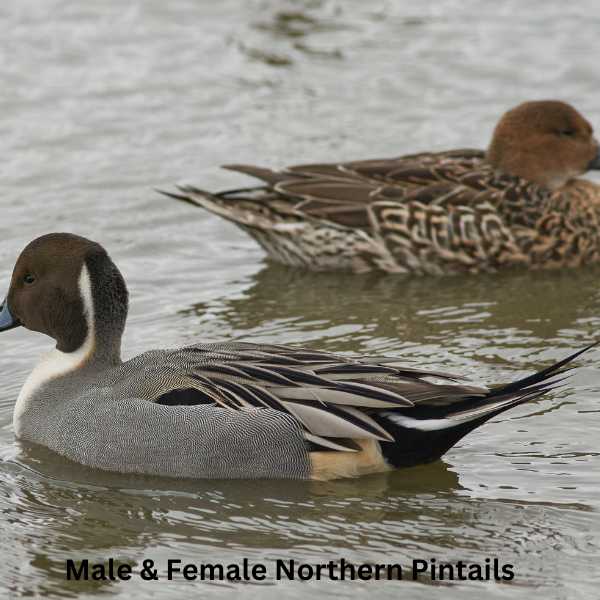
Listen to Northern Pintail
Scientific Name: Anas acuta
Length: 23–30 in
Wingspan: 31–37 in
Weight: 1 –3 lb
The Northern Pintail is a graceful species of duck recognized for their elegance in flight and their sleek bodies and long tails which is pin-shaped.
Male Northern Pintails are celebrated for their distinctive appearance, featuring a chocolate brown head, a white neck, and a grayish body. The most notable characteristic is the long, pointed tail feathers, which give this species its name. Females are more understated in color, sporting a mottled brown plumage.
Diet: Consists primarily of plant matter, including seeds and aquatic vegetation. They are also known to eat insects, especially during the breeding season. The Northern Pintail is often seen dabbling and upending in water bodies to forage for food.
Reproduction: Northern Pintails usually nest on the ground, near water bodies. The female lays a clutch of 7 to 9 eggs and is solely responsible for their incubation, which lasts for about three weeks.
Northern Shoveler
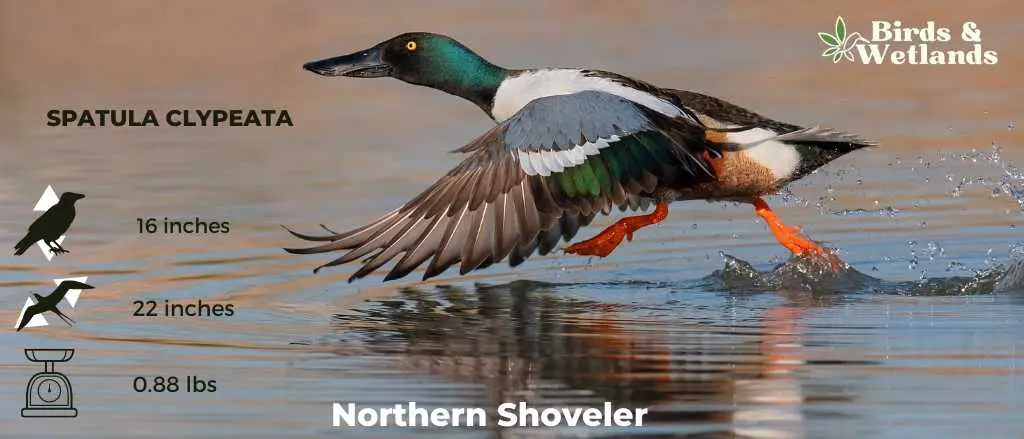
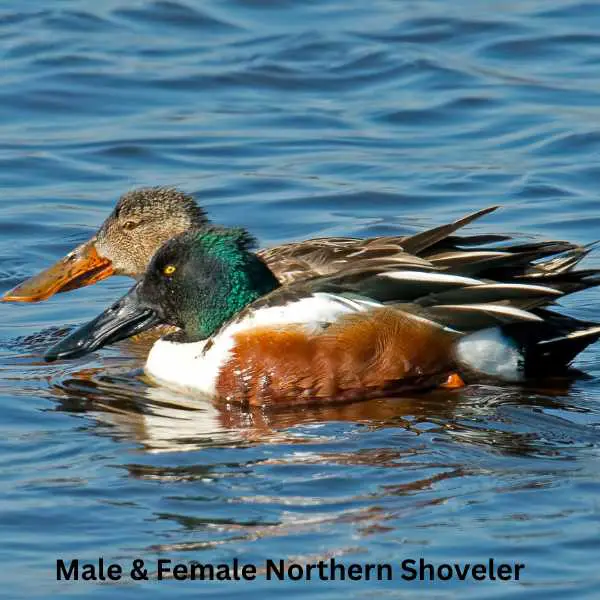
Listen to Northern Shoveler
Scientific Name: Spatula clypeata
Length: 16 in
Wingspan: 22 in
Weight: 14 oz
The Northern Shoveler is a distinct species of dabbling duck celebrated for its long, spoon-shaped bill, a feature that sets it apart from other ducks and gives the bird its name.
Appearance: Male Northern Shovelers are particularly striking, boasting a green head, yellow eyes, a large black bill, and a white chest, complemented by a chestnut-colored body. Females, on the other hand, feature a more muted color scheme, primarily displaying mottled brown feathers across their bodies and a slate-gray bill.
Diet: The Northern Shoveler’s unique bill is perfectly adapted for its feeding habits. The edges of the bill are furnished with comb-like structures that enable the bird to filter food from water. Their diet predominantly consists of aquatic invertebrates and plant matter, including seeds and algae.
Reproduction: Northern Shovelers typically nest on the ground, concealed within dense, grassy areas close to water bodies. The female lays a clutch of about 9 to 12 eggs and is solely responsible for their incubation, which lasts for about three to four weeks.
Blue-winged Teal
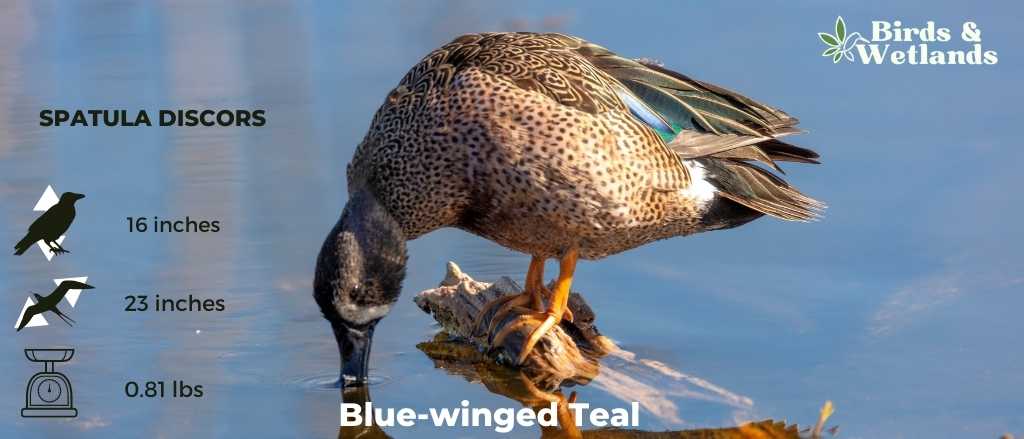
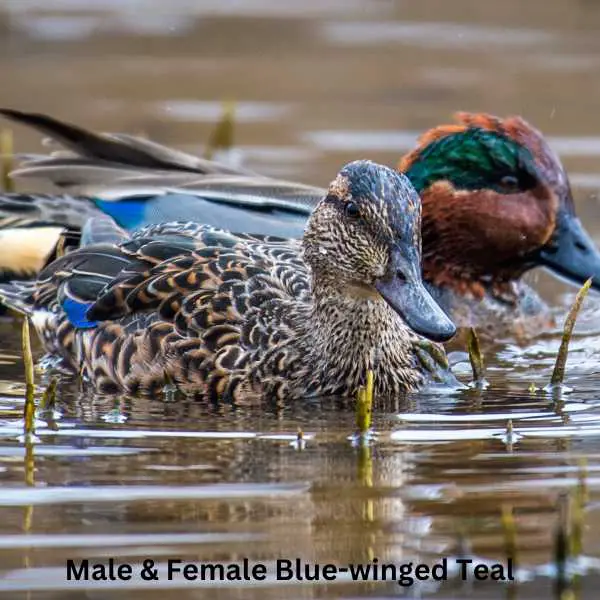
Listen to Blue-winged Teal
Scientific Name: Spatula discors
Length: 16 in
Wingspan: 23 in
Weight: 13 oz
The Blue-winged Teal is a small species of dabbling duck known for its striking plumage and its extensive migratory habits.
Appearance: Male Blue-winged Teals are quite colorful, with a slate gray head and neck, a white crescent in front of the eyes, and a predominantly brown body with specks of black. The name “Blue-winged” comes from the patch of blue feathers visible on their wings during flight. Females, in contrast, are primarily brown and subtly mottled to provide camouflage.
Diet: The Blue-winged Teal feeds mainly on plant matter, such as seeds and aquatic vegetation. However, they also supplement their diet with small invertebrates, especially during the breeding season. They are known for their “dabbling” behavior, where they feed at the surface of the water rather than diving.
Reproduction: Blue-winged Teals prefer to nest on the ground in grassy areas near water. The female typically lays a clutch of 9 to 13 eggs, which she incubates alone for about three weeks. After hatching, the ducklings can feed themselves but remain under the mother’s protection until they are capable of flying.
Wood Duck
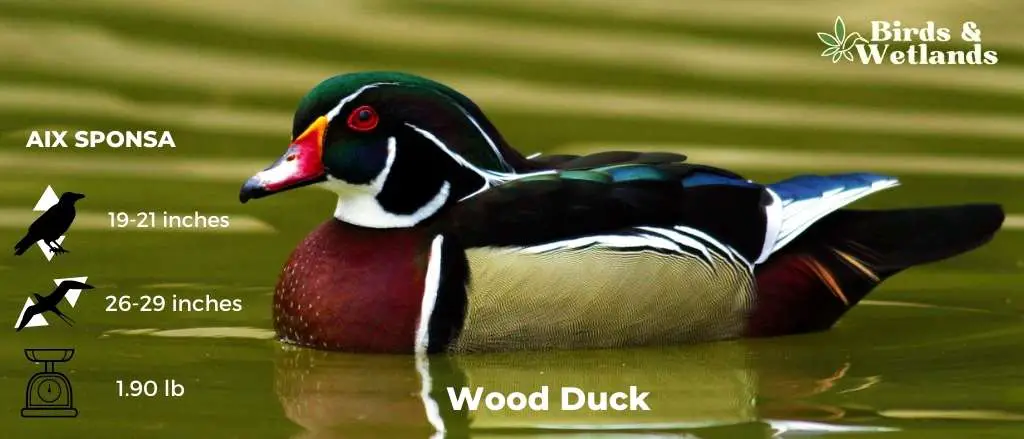
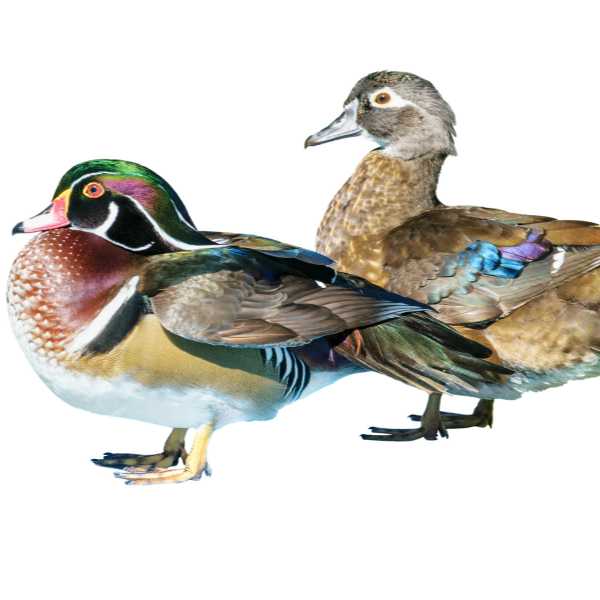
Listen:
Scientific Name: Aix sponsa
Length: 19 to 21 in
Wingspan: 26 to 29 in
Weight: 16.0-30.4 oz
The Wood Duck is an exquisitely colorful waterfowl known for its unique nesting habits and is commonly seen in wooded swamps, marshes, and streams across North America.
Appearance: With their dazzling plumage, Wood Ducks are among the most stunning birds. Males display a multitude of colors, including a green and purple crested head, red eyes, and a white-striped chest, all contrasted with a bronze-colored body. Females, though more subdued with a gray-brown body and white eye-ring, also possess their own charm.
Diet: Wood Ducks have a diverse diet that includes seeds, fruits, and insects, as well as other invertebrates. Their broad diet helps them to adapt to a variety of habitats, whether in the wild or in urban areas with suitable nesting sites.
Reproduction: Unlike most other ducks, Wood Ducks prefer to nest in tree cavities near water, leading to their common name. They will also readily use nest boxes if they’re available. A typical clutch consists of 9 to 14 eggs, which the female incubates alone.
Bufflehead

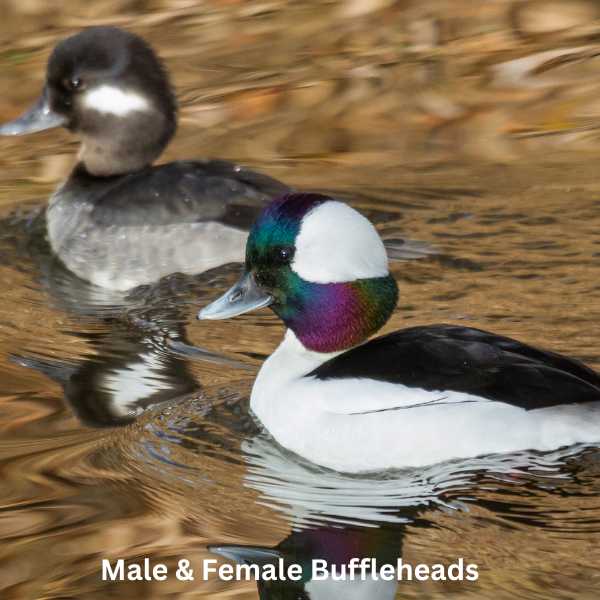
Listen to Bufflehead
Scientific Name: Bucephala albeola
Length: 13–16 in
Wingspan: 21.6 in -23.2 in
Weight: 9.5–19.4 oz
The Bufflehead is a small, compact species of diving duck known for its striking appearance and large heads and unique nesting habits.
Appearance: Male Buffleheads are easily recognized by their large, bulbous head with a green-purple iridescent sheen, a large white patch across the back of the head, and a predominantly black and white body. Females are more subtly colored, primarily in gray-brown tones with a smaller white cheek patch.
Diet: As diving ducks, Buffleheads feed by diving beneath the water’s surface. Their diet consists largely of aquatic invertebrates, such as insects, crustaceans, and mollusks, as well as some plant matter.
Reproduction: Uniquely among ducks, Buffleheads often nest in tree cavities, especially those made by Northern Flickers, a type of woodpecker. The female lays a clutch of about 6 to 11 eggs, which she incubates alone for roughly a month.
Hooded Merganser
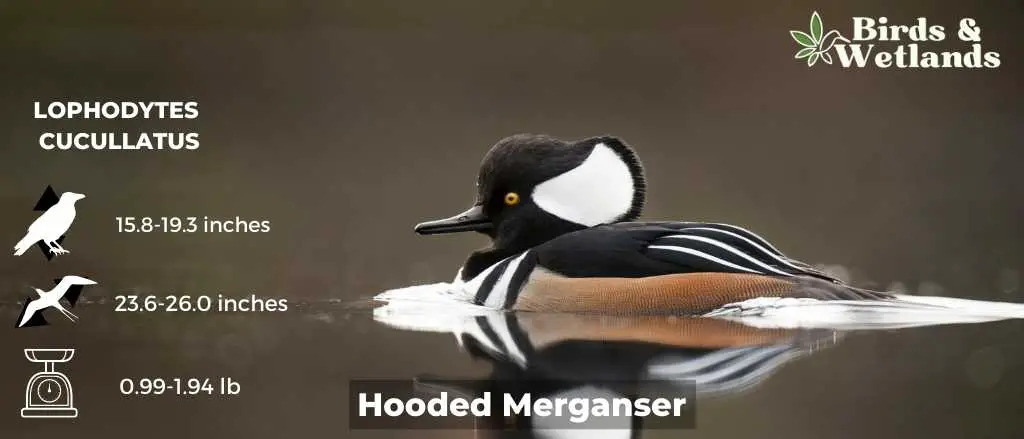
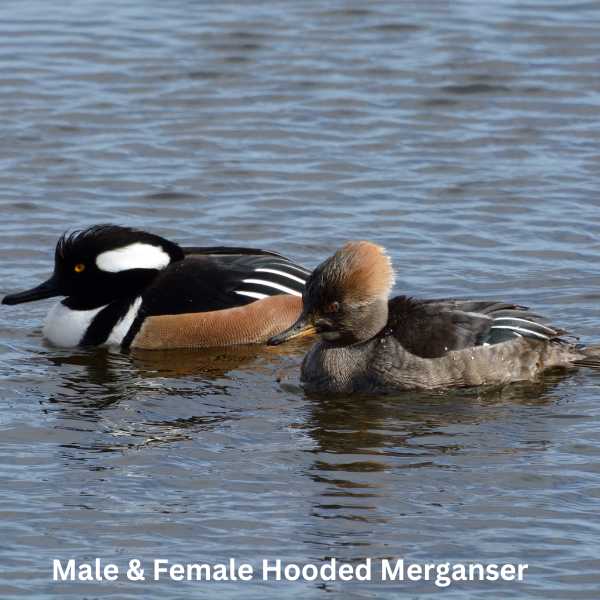
Listen to Hooded Merganser
Scientific Name: Lophodytes cucullatus
Length: 15.8-19.3 in
Wingspan: 23.6-26.0 in
Weight: 16.0-31.0 oz
The Hooded Merganser is a distinctive species of diving duck known for its showy crest and its excellent diving skills.
Appearance: Male Hooded Mergansers are especially striking with a large, fan-shaped, black and white crest, which can be expanded or contracted. They have bright yellow eyes, a dark back, and a white chest. The females have a more understated appearance with a brownish body, a smaller, reddish-brown crest, and dark eyes.
Diet: Consists of small fish, aquatic insects, and crustaceans. Their eyes are specially adapted for underwater vision, allowing them to spot and catch prey while diving.
Reproduction: Similar to Buffleheads, Hooded Mergansers often nest in tree cavities near water bodies. The female lays a clutch of about 10 to 12 eggs and incubates them alone for about a month.
Black-bellied whistling duck
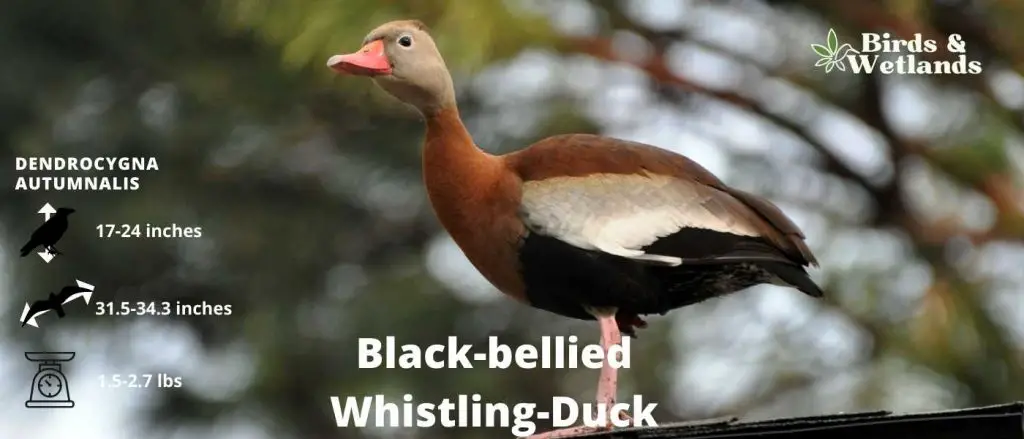

Listen
Scientific Name: Dendrocygna autumnalis
Length: 17-24 inches
Wingspan: 31.5-34.3 in
Weight: 1.5-2.7 lbs
The Black-bellied Whistling Duck is a unique species known for its high-pitched whistling call, and it is one of the few duck species that have strong monogamous relationships.
Appearance: The Black-bellied Whistling Duck is notable for its bright coral-red bill, long pink legs, and its namesake black belly. It has a grey face and chest, and its back is covered with brown feathers that give a scaled appearance. Both males and females share a similar color pattern, making it difficult to distinguish between the two.
Diet: This duck’s diet is mainly vegetarian, consisting predominantly of seeds and grains. They also consume insects, snails, and other small invertebrates. Unlike many other ducks, Black-bellied Whistling Ducks often forage on land, especially at night.
Reproduction: Black-bellied Whistling Ducks usually nest in tree cavities near water, but they will also use nest boxes. The female typically lays between 9 to 16 eggs.
Ross’s Goose
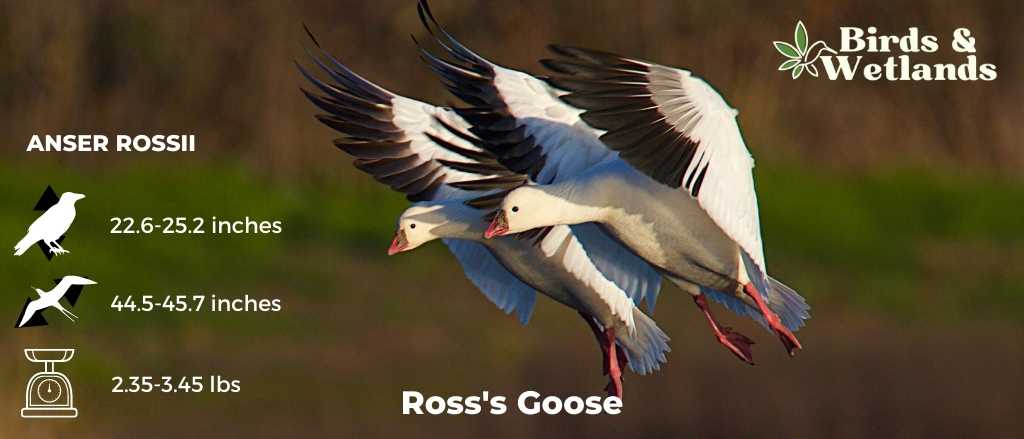
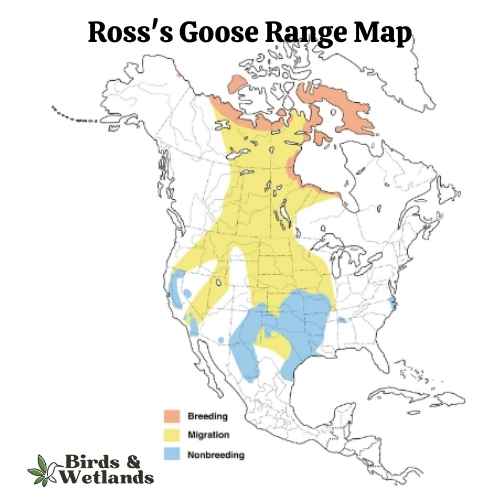
Listen
Scientific Name: Anser rossii
Length: 23.2-25.2
Wingspan: 44.5-45.7 in
Weight:42.3-55.3 oz
The Ross’s Goose is a small species of waterfowl often found in North America’s tundra and wetland habitats.
Appearance: Known for its compact size, the Ross’s Goose is mostly white with black wingtips. It features a short, stubby bill and a rounded head. One key identifying feature is the blueish gray base of its bill, which has a warty structure during the breeding season.
Diet: This goose feeds mainly on vegetation, including seeds, leaves, and roots of grasses and sedges. During winter and migration, they also consume grains and seeds from agricultural fields.
Reproduction: The Ross’s Goose nests on the ground, often in colonies. The female lays a clutch of 2 to 5 eggs which she incubates for around three weeks. The young geese, known as goslings, are precocial – they can walk, swim, and feed themselves shortly after hatching, although they stay with their parents until they learn to fly.
Greater White-fronted Goose
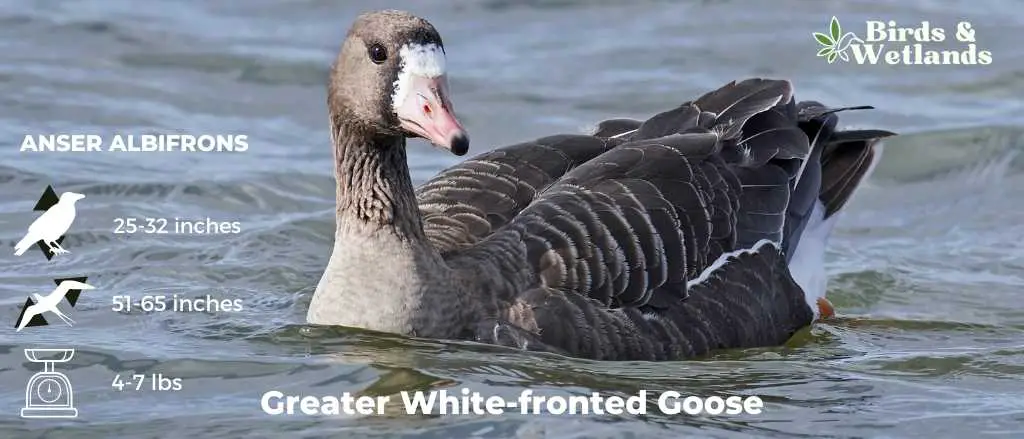
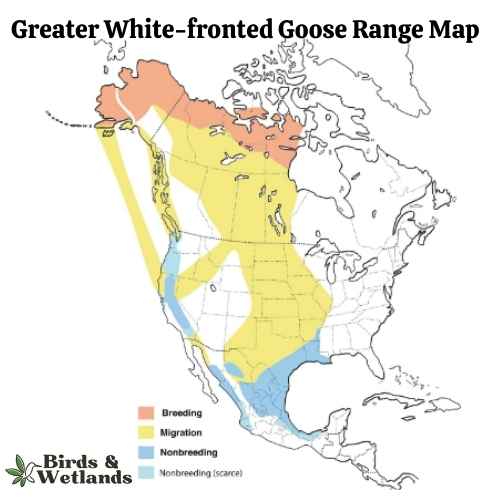
Listen
Scientific Name: Anser albifrons
Length: 25 to 31 in
Wingspan: 53 to 66 in
Weight: 3.3 to 6.6
The Greater White-fronted Goose is a medium to large waterfowl species, widely distributed across the Northern Hemisphere, particularly in North America.
Appearance: As the name suggests, these geese display a prominent white patch at the base of their bill. Their bodies are gray-brown, and their breasts are often marked with dark blotches. They possess a pinkish bill and orange legs and feet.
Diet: The Greater White-fronted Goose is a herbivore and feeds mainly on plant material. Its diet consists of grasses, sedges, grains, and berries. When wintering, these geese can often be found in agricultural fields, feasting on leftover grains and crops.
Reproduction: This species nests on the ground, often in areas with good visibility such as slopes or ridges. The female lays a clutch of 4 to 5 eggs, which she incubates for nearly a month. Once hatched, the young ones are taken care of by both parents until they are able to fly.
Snow Goose
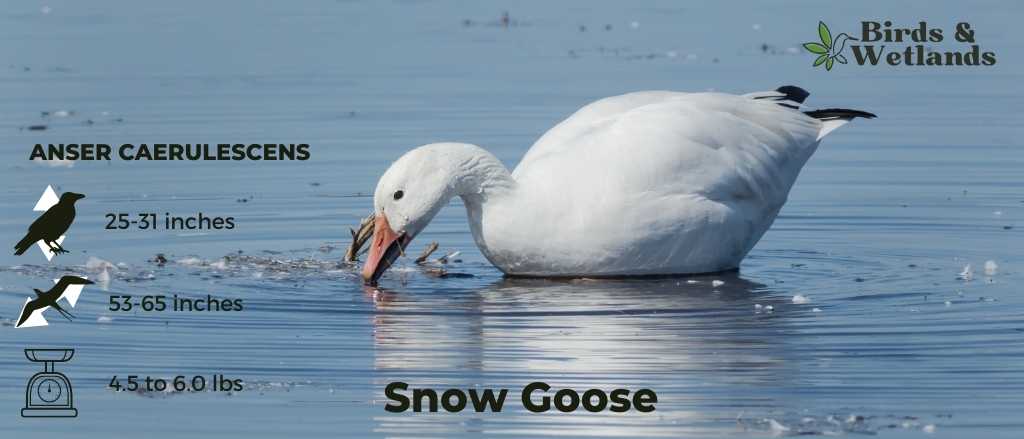
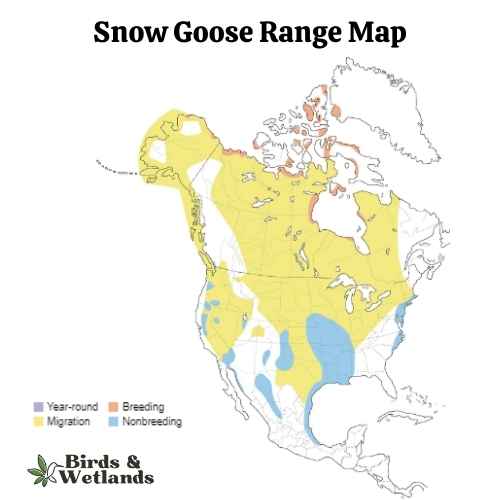
Snow Goose Sound
Scientific Name: Anser caerulescens
Length: 25 to 31 in
Wingspan: 53 to 65 in
Weight: 4.5 to 6.0
The Snow Goose is a large species of waterfowl known for its vibrant white plumage and significant migratory flights.
Appearance: True to their name, Snow Geese are predominantly white with black wingtips. They also have a pink bill, pink legs and feet. A color morph, known as the “Blue Goose,” displays a bluish-gray body with a white head, but is considered the same species.
Diet: Snow Geese primarily feed on plant matter, such as grasses, sedges, and small grains. They can often be seen in large flocks foraging in fields and marshes, and during migration and winter, they can cause considerable damage to agricultural fields due to their feeding habits.
Reproduction: Snow Geese typically nest on the tundra, near water bodies. The female builds the nest and lays a clutch of about 3 to 5 eggs, which she incubates alone for approximately three weeks. Once hatched, the goslings can feed themselves but stay with their parents for protection until they can fly.
Trumpeter Swan
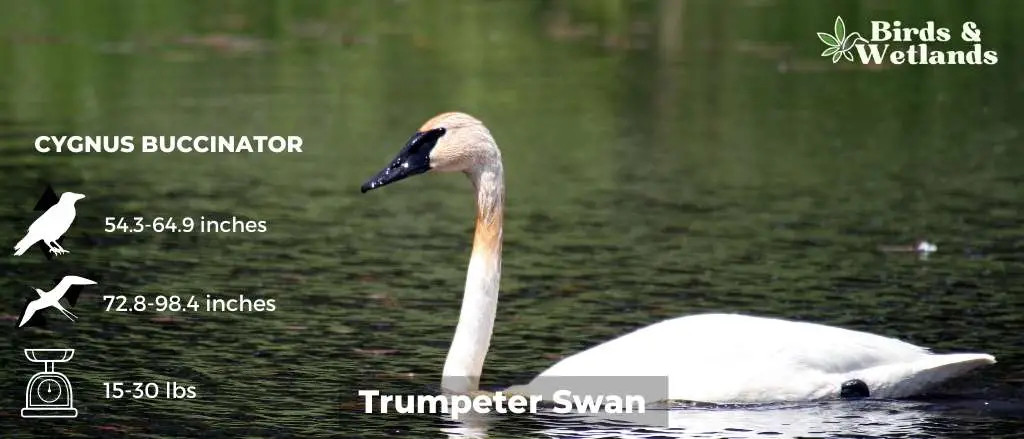
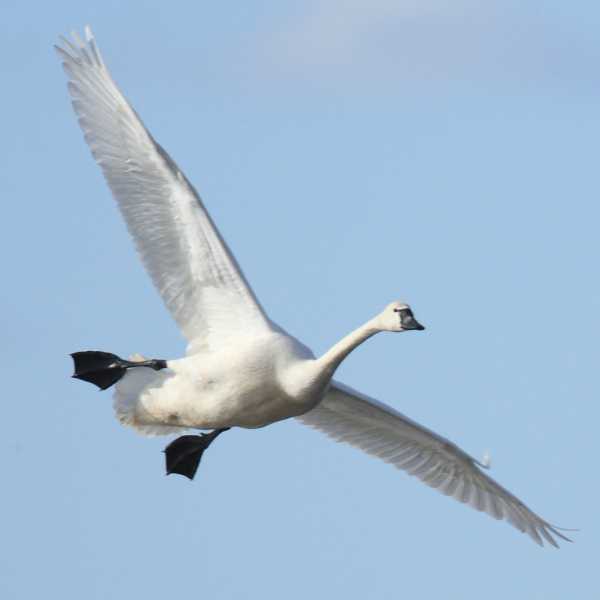
Listen:
Scientific Name: Cygnus buccinator
Length: 4 ft 6 in – 5 ft 5 in
Wingspan: 185 to 250 cm
Weight:7–13.6 kg
The Trumpeter Swan is one of the heaviest flying birds in North America, known for its impressive size and majestic presence.
Appearance: The Trumpeter Swan is predominantly white, with a long, elegant neck and a black bill. The adults are distinguishable from other swans by their straight, not curved, neck when swimming. They have a wingspan that can extend up to 10 feet, making them a truly magnificent sight to behold.
Diet: These swans are herbivores and primarily feed on aquatic plants. They forage in shallow water, often submerging their heads and necks to reach underwater vegetation. They may also graze on land when available.
Reproduction: Trumpeter Swans usually nest near water bodies, creating large nests made from plant material. The female lays 3 to 5 eggs and the incubation period lasts about a month.
Green Heron

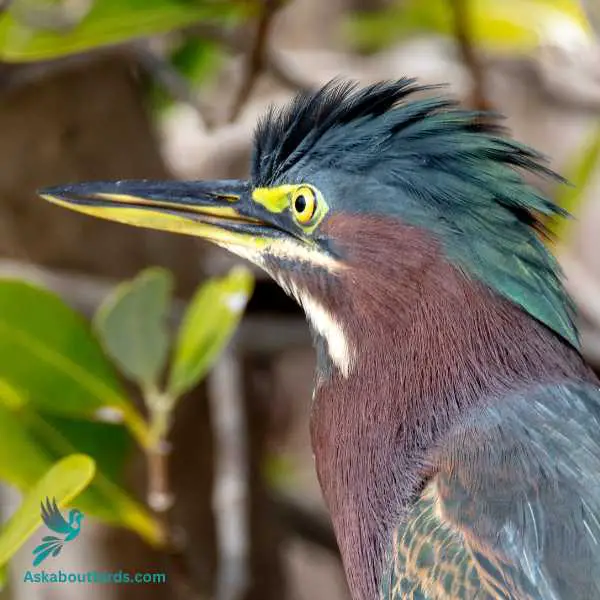
| Feature | Measurement |
|---|---|
| Scientific Name | Butorides virescens |
| Length | 16-18 inches |
| Wingspan | 25-27 inches |
| Weight | 6-7 ounces |
The Green Heron is a small heron found in North America, notable for its deep green back and chestnut body, as well as its unique fishing tactics.
Appearance: Green Herons are dark and compact birds with a glossy, greenish-black cap, a greenish back and wings, and chestnut neck and belly. The bill is long, dark and sharply pointed. Their legs are bright orange or yellow. Young birds are duller in color, with a dark top and streaked brown front.
Diet: The Green Heron’s diet is quite varied, consisting mostly of small fish, but also includes insects, spiders, and sometimes amphibians and small mammals. It’s known for its tool-using behavior where it drops bait onto the water’s surface to attract fish.
Reproduction: Green Herons are solitary birds except during the breeding season, where they form monogamous pairs. Nests are typically built in trees or shrubs near water. Females lay 2 to 5 pale blue-green eggs that both parents incubate.
Great Blue Heron


| Feature | Measurement |
|---|---|
| Scientific Name | Ardea herodias |
| Length | 36–54 in |
| Wingspan | 66–79 in |
| Weight | 1.82–3.6 kgs |
Great Blue Herons are the largest heron species in North America, is distinguished by its tall stature and unique blue-gray plumage.
Measuring up to 4.5 feet tall with a wingspan of approximately 6.5 feet, the bird features a long, pointed bill, a white head with a black eye stripe extending to slender black plumes, and robust, elongated legs. Its distinctive flight pattern, forming a tight “S” shape with its neck, sets it apart from similar large birds, like cranes.
Inhabiting various wetland habitats, including marshes, lakes, rivers, and coastal regions throughout much of North and Central America, the Great Blue Heron is a wading bird. Often seen poised statue-like at the water’s edge, these birds are expert hunters, spearing fish and capturing small animals with their sharp bills.
Spotted Sandpiper
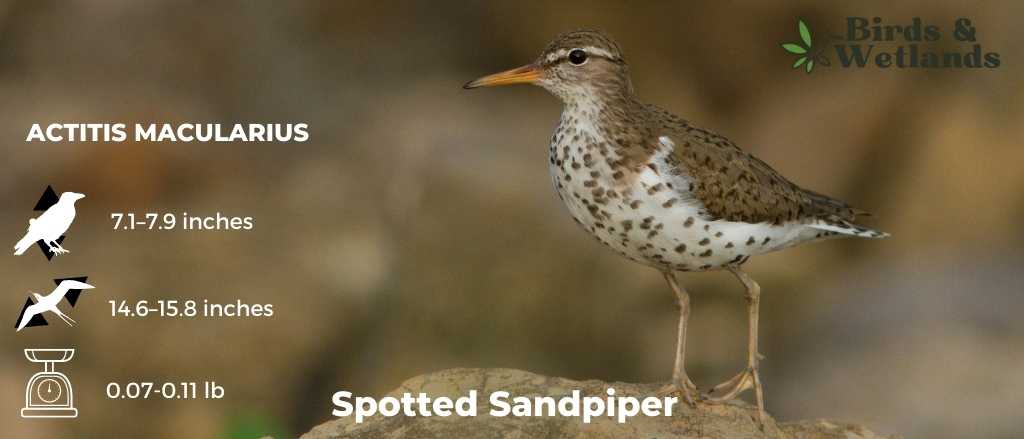
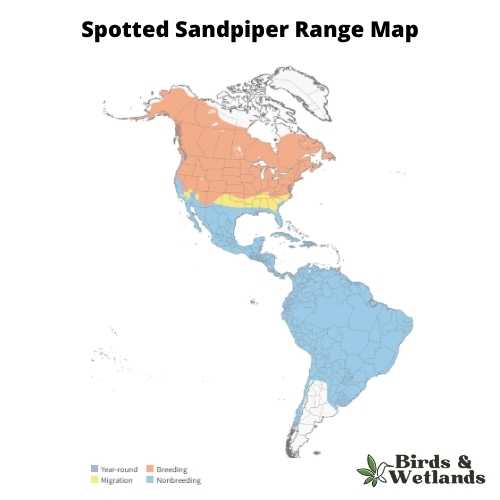
Listen
Scientific Name: Actitis macularius
Length: 7.1–7.9 in
Wingspan: 14.6–15.8 in
Weight: 1.2-1.8 oz
The Spotted Sandpiper is a small and distinctive shorebird, well-known for its teetering motion when it walks or feeds.
Appearance: Spotted Sandpipers have a brown back and white belly. They sport dark spots on their underparts during the breeding season, hence the name. In flight, they display a characteristic white wing stripe. Their bill is orange with a dark tip, and they have yellowish-orange legs.
Diet: They primarily feed on small invertebrates, insects, and occasionally small fish. They forage along water edges or on mudflats, pecking or probing the ground for food.
Reproduction: Spotted Sandpipers are unique among birds as the females establish and defend territories. They lay 3 to 5 eggs in a ground nest, typically hidden in vegetation near water bodies. After laying, the female may leave the male to incubate the eggs and care for the young, while she moves on to breed with another male.
Great Egret


| Feature | Measurement |
|---|---|
| Scientific Name | Ardea alba |
| Length | 31 to 41 in |
| Wingspan | 52 to 67 in |
| Weight | 1.5 to 3.3 lbs |
The Great Egret (Ardea alba), also known as the Common Egret, is a large, elegant wading bird recognized for its brilliant white plumage, slender black legs, and long, dagger-like yellow bill.
With a height of up to 3.3 feet and a wingspan of 52 to 67 inches, this bird is amongst the largest of the heron species. Its stately appearance and serene comportment have made it a popular symbol in many cultures and an eye-catching sight in its habitats.
Found across all continents except Antarctica, the Great Egret resides in both fresh and saltwater wetlands, including marshes, ponds, and coastal areas. It feeds mainly on fish, but it also hunts amphibians, small mammals, and invertebrates.
Cattle Egret
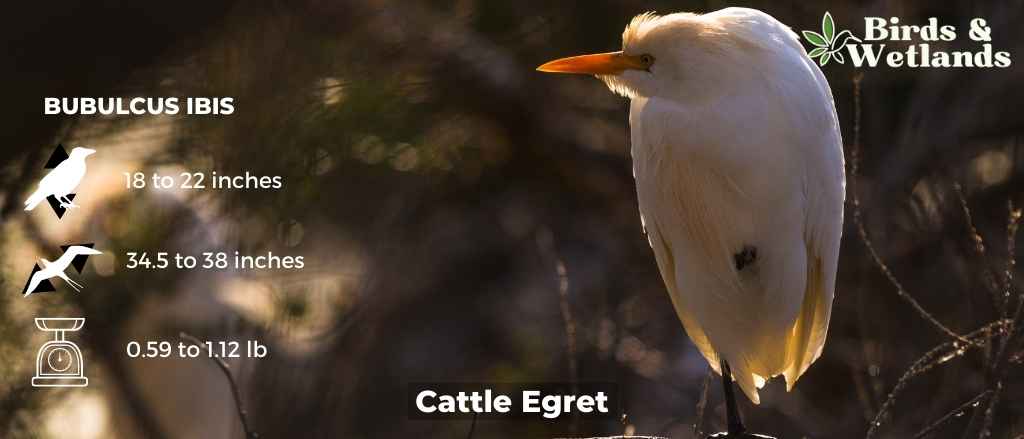

Listen:
Scientific Name: Bubulcus ibis
Length: 18–22 in
Wingspan: 34–38 in
Weight: 9–18 oz
The Cattle Egret is a small, adaptable heron species known for its unique symbiotic relationship with large mammals. Originally native to parts of Asia, Africa, and Europe, they have successfully expanded to all other continents, including North America.
Appearance: Cattle Egrets are relatively small for a heron and exhibit a compact body shape. They have a white body with a slightly hunched posture and a yellow bill and legs. During the breeding season, adults develop buff-colored patches on their chest, back, and crown.
Diet: Unlike most herons, Cattle Egrets tend to forage on dry land, often around livestock. Their diet primarily consists of insects, especially those disturbed by cattle or other large animals. They have also been known to eat spiders, frogs, and other small animals.
Reproduction: Cattle Egrets nest in colonies, often with other heron species. They build a sturdy nest out of sticks in trees or shrubs where the female lays 3 to 4 eggs.
White-faced Ibis
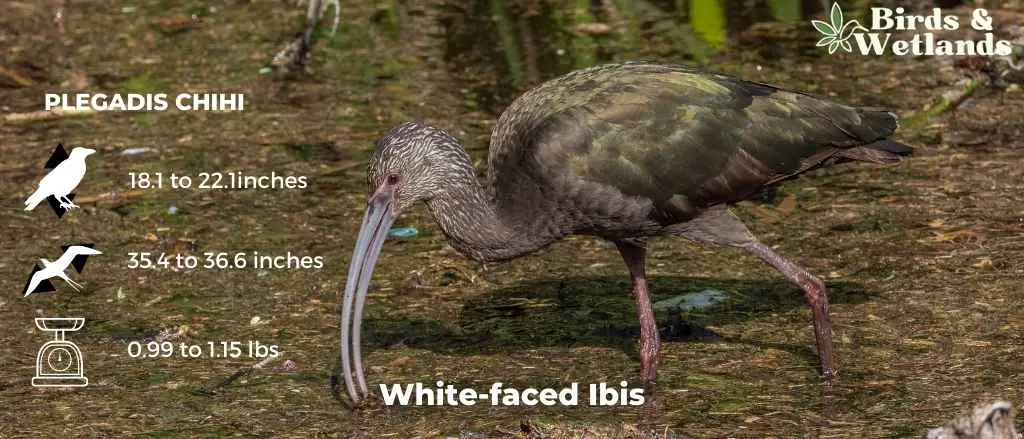
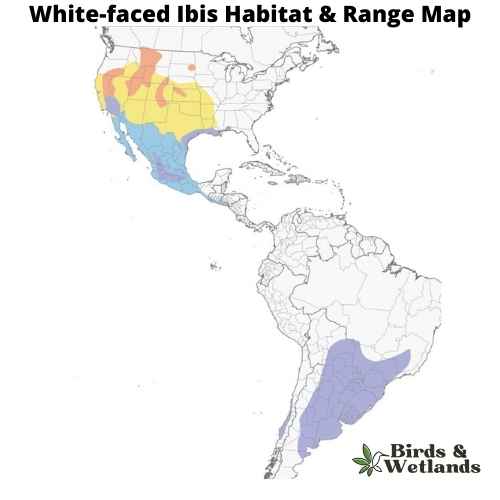
Listen
Scientific Name: Plegadis chihi
Length: 18.1-22.1 in
Wingspan: 35.4-36.6 in
Weight: 15.9-18.5 oz
The White-faced Ibis is a wading bird that is most commonly found in the marshes, swamps, and wetlands of the Western United States.
Appearance: The White-faced Ibis stands out for its iridescent dark red-brown body, a slim and curved bill, and long grayish legs. Its name comes from a distinguishing feature seen in adults – a thin band of white feathers around the base of the bill and eye during the breeding season. Its eyes are reddish, which further adds to its distinctive appearance.
Diet: The diet of the White-faced Ibis primarily consists of insects, crustaceans, snails, and small fish. With their long, curved bills, they probe into the soft mud in search of these food items.
Reproduction: The White-faced Ibis typically builds its nest in low shrubs or trees near water bodies, using sticks and other vegetation. It lays a clutch of 3 to 5 eggs that are light blue in color. Both parents share the responsibility of incubating the eggs for about three weeks.
Common Loon

Listen:
Scientific Name: Gavia immer
Length: 24-39 in
Wingspan: 50-56 in
Weight: 6.4-13.6 lbs
The Common Loon is a large, iconic water bird that can be found in many parts of North America. It is known for its haunting calls, often heard in the early morning or late evening across the region’s lakes and ponds.
Appearance: The Common Loon is celebrated for its striking black-and-white breeding plumage, a red eye, and a robust, black bill. In winter, its plumage turns to a more subdued gray, but its large, sturdy body and pointed bill remain distinctive.
Diet: Common Loons primarily feed on fish, but also consume crustaceans, frogs, and aquatic insects. They are expert divers, capable of plunging deep underwater to catch their prey, and are often observed popping their heads above water before diving for their next meal.
Reproduction: The Common Loon nests near water, typically on lakes and larger ponds in the northern parts of North America. The female generally lays 1-2 eggs per year in a nest made from vegetation on the ground. Both parents share the responsibility of incubating the eggs and feeding the young.
American Coot
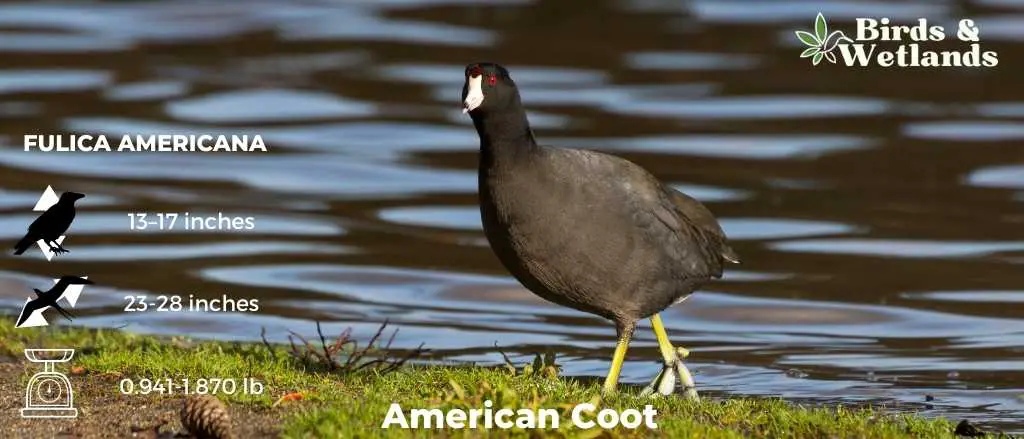
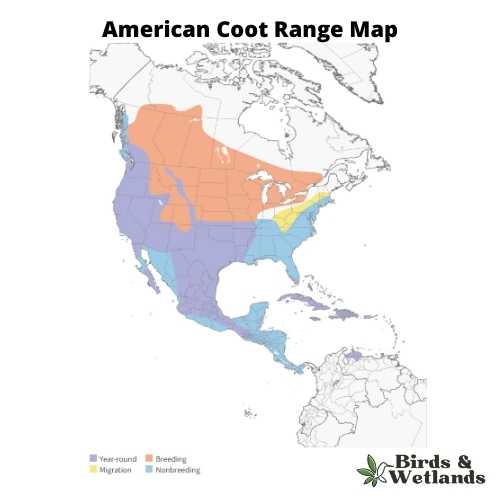
Listen:
Scientific Name: Fulica americana
Length: 13–17 in
Wingspan: 23 to 28 in
Weight: 1.270 to 1.870 lb
The American Coot is a ubiquitous water bird commonly seen in the wetlands, lakes, and ponds of North America, recognized for its adaptability and striking features.
Appearance: American Coots are easily identifiable by their slate-gray bodies, offset by a white, chicken-like bill and a red eye. Their legs are also distinctive, equipped with lobed toes, as opposed to the webbed feet seen in ducks, which assist them in navigating both land and water adeptly.
Diet: While aquatic plants form the bulk of an American Coot’s diet, they aren’t strictly herbivores. These versatile birds also consume small invertebrates and fish, demonstrating their ability to adapt and survive in a variety of habitats.
Reproduction: Nesting for the American Coot usually happens in shallow water bodies, where they construct a floating nest hidden among the vegetation. A clutch can contain between 8 to 12 eggs, all of which are incubated by both parents.
Double-crested cormorant

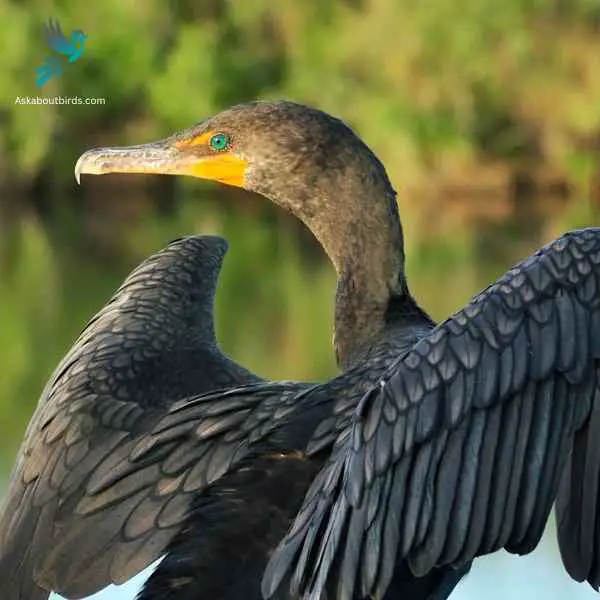
| Feature | Measurement |
|---|---|
| Scientific Name | Nannopterum auritum |
| Length | 28–35 in |
| Wingspan | 45–48 in |
| Weight | 1.2–2.5 kg |
The Double-Crested Cormorant (Phalacrocorax auritus) is a large waterbird known for its long neck, hooked bill, and almost entirely black body. The species gets its name from the two small patches of tufted feathers or “crests” found on the heads of breeding adults, one on each side. These birds are strong swimmers that propel themselves underwater with their webbed feet, their bodies submerged and necks above the water surface, giving them a characteristic snake-like appearance when swimming.
Double-Crested Cormorants are widely distributed across North America and can be found in a variety of aquatic environments including freshwater lakes, coastal areas, and rivers. Their diet primarily consists of fish, which they catch by diving from the water’s surface. Often seen perched with wings outstretched to dry after fishing, these cormorants nest in trees, on the ground, or on cliff edges, usually in colonies. While they have rebounded from decreases in the mid-20th century due to DDT-related reproductive failures, they face ongoing threats from habitat loss, entanglement in fishing gear, and conflicts with fisheries over their consumption of fish. Protection and careful management of their habitats are key to their ongoing conservation.
Pied-billed Grebe
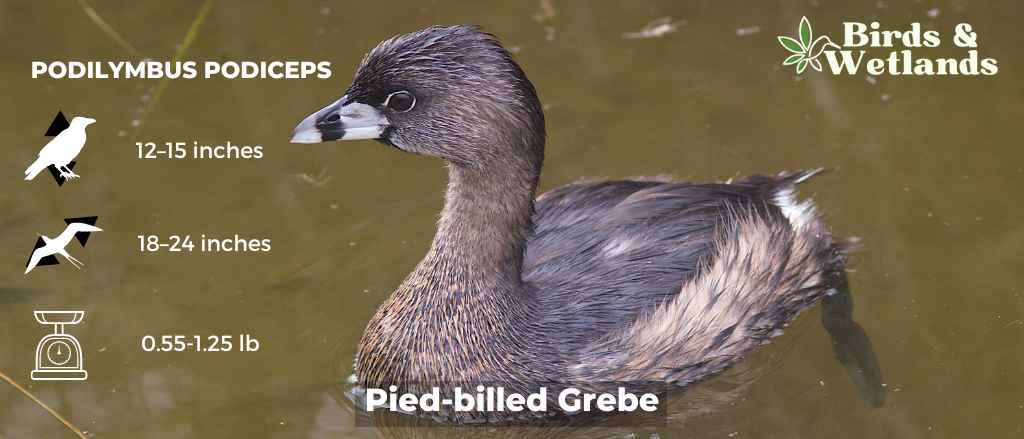
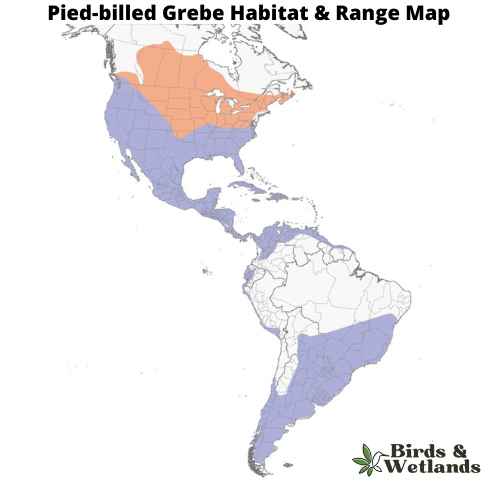
Listen:
Scientific Name: Podilymbus podiceps
Length: 12–15 in
Wingspan: 18–24 in
Weight: 8.9–20.0 oz
The Pied-billed Grebe is a small, elusive water bird well-known for its unique ability to adjust its buoyancy and often “sink” out of sight. It can be found in a wide variety of wetland habitats across the United States.
Appearance: Pied-billed Grebes have a stocky build with a short neck and a chicken-like bill that is conspicuously ringed in black during the breeding season – hence the name “pied-billed”. Their plumage is primarily a muted brown, which can vary in tone depending on the season.
Diet: Their diet consists predominantly of aquatic invertebrates, small fish, and amphibians. Pied-billed Grebes are adept divers and can stay underwater for impressive lengths of time to catch their prey.
Reproduction: Pied-billed Grebes usually nest in dense marsh vegetation, where the female lays 5 to 7 eggs. Both parents share responsibilities for incubation. After hatching, the chicks are often seen riding on their parents’ backs while they learn to navigate their aquatic world.
Eared Grebe
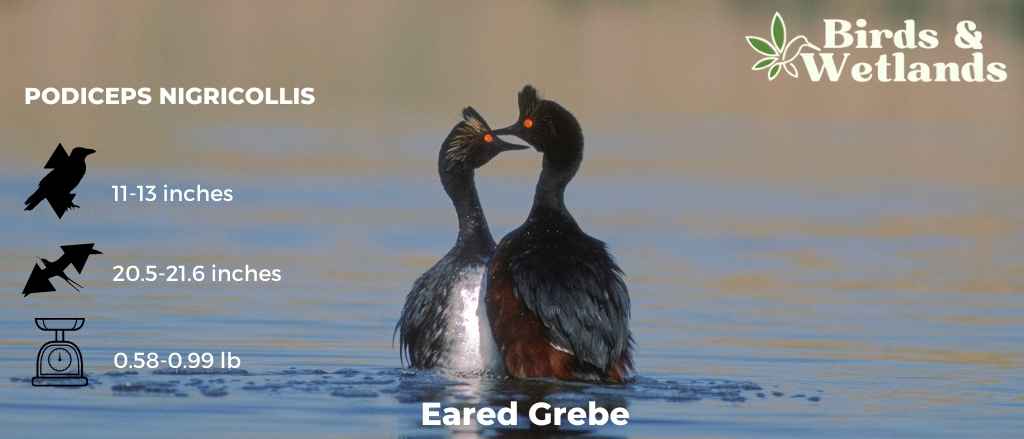

Listen:
Scientific Name: Podiceps nigricollis
Length: 11 and 13 in
Wingspan: 20.5-21.6 in
Weight: 9.3 to 15.9 oz
The Eared Grebe, often seen in large flocks, is a small waterbird known for its superb diving abilities and distinctive breeding plumage. The Eared Grebe is known to spend more time swimming underwater than any other diving bird, a testament to its exceptional aquatic abilities.
Appearance: The Eared Grebe has a slim, pointed bill and red eyes. During the breeding season, the adults develop an elaborate blackish body, with a vibrant golden tuft of feathers stretching from the eyes to the sides of the neck, which gives the species its name. In non-breeding plumage, they exhibit a more subdued gray and white color pattern.
Diet: This bird’s diet is primarily aquatic and includes insects, crustaceans, and small fish. Eared Grebes are proficient divers, often disappearing underwater for long periods to forage.
Reproduction: They generally nest in large colonies on floating vegetation in shallow water bodies. The female lays a clutch of 3 to 4 eggs.
American White Pelican


| Feature | Measurement |
|---|---|
| Scientific Name | Pelecanus erythrorhynchos |
| Length | 50–70 in |
| Wingspan | 95–120 in |
| Weight | 3.5 and 13.6 kg |
The American White Pelican (Pelecanus erythrorhynchos) is one of North America’s largest birds, distinguished by its brilliant white plumage, elongated orange bill, and massive wingspan, which can extend up to 3 meters. This bird has a unique appearance with its distinctive pouch used for feeding and a “horn” on the upper part of the bill during the breeding season. Though a large bird, it is very graceful in flight, often seen soaring in flocks in a V formation.
American White Pelicans inhabit lakes, marshes, and salt bays, and despite their size, they are excellent swimmers. They feed primarily on fish, using a cooperative hunting strategy where they encircle schools of fish in shallow water and then scoop them up in their bill pouches. Unlike their brown pelican relatives, they do not dive for their food. During the breeding season, these pelicans will nest in colonies on islands in freshwater lakes.
Where to Spot Arkansas’s Water Birds
Here are the top locations in Arkansas known for their diverse range of water birds:
Big Lake National Wildlife Refuge: Located in northeastern Arkansas, this refuge is known for its rich biodiversity. It provides a habitat for a variety of migratory birds, including the Mallard and other waterfowl species, making it a hot spot for bird watching.
Harris Brake Lake Wildlife Management Area: Home to the Northern Shoveler and numerous other bird species, this region offers a delightful birding experience, especially during migration periods when diversity peaks.
Bayou Meto Wildlife Management Area: A gem of the Natural State, Bayou Meto is renowned for its robust duck population, including the Blue-winged Teal. It’s a favored destination for bird-watchers and hunters alike.
Cache River National Wildlife Refuge: With one of the largest contiguous tracts of bottomland hardwood forest in North America, it’s home to numerous water birds including the Hooded Merganser. It’s also recognized as a Wetland of International Importance.
Millwood State Park: Situated near the town of Ashdown, this state park’s expansive lake is a habitat for various bird species, including the Great Egret. Bird watchers will appreciate the water birds’ diversity at different times of the year.
| Neighboring States to Arkansas | Best Spots to See Water Birds |
|---|---|
| Missouri Water Birds | 1. Swan Lake National Wildlife Refuge 2. Mingo National Wildlife Refuge 3. Squaw Creek National Wildlife Refuge |
| Tennessee Water Birds | 1. Reelfoot Lake State Park 2. Great Smoky Mountains National Park 3. Cross Creeks National Wildlife Refuge |
| Mississippi Water Birds | 1. Noxubee National Wildlife Refuge 2. Delta National Forest 3. Gulf Islands National Seashore |
| Louisiana Water Birds | 1. Sabine National Wildlife Refuge 2. Jean Lafitte National Historical Park and Preserve 3. Cameron Prairie National Wildlife Refuge |
| Texas Water Birds | 1. Aransas National Wildlife Refuge 2. Padre Island National Seashore 3. High Island |
| Oklahoma Water Birds | 1. Sequoyah National Wildlife Refuge 2. Salt Plains National Wildlife Refuge 3. Little River National Wildlife Refuge |
Aquatic birds come in all shapes and sizes from large birds down to tiny ducks hidden in dense vegetation. Many of these birds migrate south and only briefly stop in Arkanas. its worth check the Arkansas Audubon society too see what bird species are common and when for your bird watching session!

